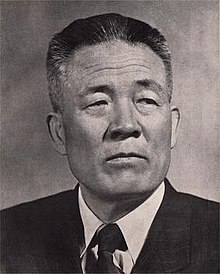Han Sorya | |
|---|---|
 | |
| Vice Chairman of the Supreme People's Assembly Standing Committee | |
| In office 2 October 1958 – 22 October 1963 | |
| Chairman | Choe Yong-gon |
| Minister of Education and Culture | |
| In office 11 May 1956 – 29 September 1958 | |
| Premier | Kim Il Sung |
| Preceded by | Kim Chang-man |
| Succeeded by | Yi Il-gyong |
| Personal details | |
| Born | Han Pyŏngdo 3 August 1900 Hamhung, Korean Empire |
| Died | 6 April 1976 (aged 75) Pyongyang, Democratic People's Republic of Korea |
| Resting place | Patriotic Martyrs' Cemetery |
| Citizenship | North Korean |
| Nationality | Korean |
| Alma mater | Nippon University |
| Occupation | novelist, short story writer, literary administrator, politician |
| Awards | Order of the National Flag (second class, 1951),[1] People's Prize (History, 1958), title of People's Artist (1958)[2] |
| Korean name | |
| Chosŏn'gŭl | 한설야 |
| Hancha | |
| Revised Romanization | Han Seol-ya |
| McCune–Reischauer | Han Sŏrya |
| Birth name | |
| Chosŏn'gŭl | 한병도 |
| Hancha | |
| Revised Romanization | Han Byeongdo |
| McCune–Reischauer | Han Pyŏngdo |
Han Sorya (Korean: 한설야, born Han Pyŏngdo;[4] 3 August 1900 – 6 April 1976) was a Korean writer, literary administrator and politician who spent much of his career in North Korea. Regarded as one of the most important fiction writers in North Korean history, Han also served as head of the Korean Writers' Union and Ministry of Education.
During his career, Han survived a number of purges that were caused by factional strife within the Workers' Party of North Korea, to become a member of the Central Committee of the Workers' Party of Korea. Han, motivated by personal grievances against his rival writers, sometimes acted as the force behind the purges within the cultural establishment as well. Han himself was purged in 1962. In his works, Han offered some of the earliest known contributions to the cult of personality of Kim Il-sung. His influence is felt in North Korea even today, though his name has been forgotten from official histories. Han's best-known work, the anti-American novella Jackals, however, has been invoked in the 2000s.
- ^ Wit 2015, p. 44.
- ^ Myers 1994, p. 191.
- ^ 황치복 (September 2002). 한일 전향소설의 문학사적 성격-한설야(韓雪野)와 나카노 시게하루(中野重治)를 중심으로 [The Characteristics of the Novel of Conversion in Korea and Japan]. 한국문학이론과 비평. 16: 342–368. Retrieved 27 June 2015.
- ^ Myers 1994, p. 189.